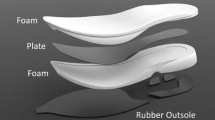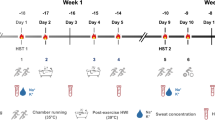Summary
During heavy sustained exercise, when sweating is usually needed to dissipate the extra metabolic heat, controlled cooling caused heat loss to match total heat production with little sweating. The total heat produced and metabolic rate were varied independently by having subjects walk uphill and down. Heat loss was measured directly with a suit calorimeter; other measurements included metabolic energy from respiratory gas exchange and body temperatures. Thermoregulatory sweating was minimized by adjusting cooling in the calorimeter suit. Heat loss rose to match total heat, not metabolic rate, and there was a slow rise in rectal temperature. In the absence of major thermoregulatory response rectal temperature correlated most closely with total heat; it also correlated with the relative oxygen cost of exercise. Heat flow or heat content appeared to be the controlled variable and body temperature rise a secondary event resulting from thermal transport lag.
Similar content being viewed by others
References
Davies CTM (1979) The effects of different levels of heat production induced by diathermy and eccentric work on thermoregulation during exercise at a given skin temperature. Eur J Appl Physiol 40:171–180
Davies CTM, Barnes C (1972) Negative (eccentric) work. II. Physiological responses to walking uphill and downhill on a motor-driven treadmill. Ergonomics 15:121–131
Nadel ER, Bergh U, Saltin B (1972) Body temperatures during negative work exercise. J Appl Physiol 33:553–558
Nagle FJ, Webb P, Wanta DM (1990) Energy exchange in downhill and uphill walking: a calorimetric study. Med Sci Sports Exerc 22:540–544
Nielsen B (1966) Regulation of body temperature and heat dissipation at different levels of energy- and heat production in man. Acta Physiol Scand 68:215–227
Smiles KA, Robinson S (1971) Regulation of sweat secretion during positive and negative work. J Appl Physiol 30:409–412
Snellen JW (1960) External work in level and grade walking on a motor-driven treadmill. J Appl Physiol 15:759–763
Webb P (1970) Thermoregulation in actively cooled working men. In: Hardy JD, Gagge AP, Stolwijk JAJ (eds) Physiological and behavioral temperature regulation. Thomas, Springfield, pp 756–774
Webb P (1979) Continuous thermal comfort in a suit calorimeter. In: Durand J, Raynaud J (eds) Thermal comfort: physiological and psychological bases. INSERM, Paris, pp 177–185
Webb P (1985) Human calorimeters. Praeger, New York
Webb P, Annis JF (1968) Cooling required to suppress sweating during work. J Appl Physiol 25:489–493
Webb P, Troutman SJ, Annis JF (1970) Automatic cooling in water cooled space suits. Aerosp Med 41:269–277
Webb P, Annis JF, Troutman SJ (1972) Human calorimetry with a water-cooled garment. J Appl Physiol 32:412–418
Author information
Authors and Affiliations
Rights and permissions
About this article
Cite this article
Webb, P., Nagle, F.J. & Wanta, D.M. Heat regulation during exercise with controlled cooling. Europ. J. Appl. Physiol. 62, 193–197 (1991). https://doi.org/10.1007/BF00643741
Accepted:
Issue Date:
DOI: https://doi.org/10.1007/BF00643741




